H2-powered fuel cell trucks: Three technologies
Hydrogen renewable energy has a key role to play in heavy road transport and HDVs (heavy duty vehicles) to achieve the goal of decarbonising a sector considered to be exceedingly difficult to electrify. The transport sector accounts for 25% of total greenhouse gas emissions in Spain, according to data provided by the MITECO (Ministry for Ecological Transition and Demographic Challenge). The evolution towards low-carbon economic models is among the challenges to be faced by developed societies in terms of mobility. Therefore, hydrogen-powered fuel cell trucks have and will have a key role to play in achieving this challenging task of decarbonisation of heavy-duty road transport, in which the use of renewable hydrogen as a fuel is more suitable than other solutions that are being considered. As shown in the figure below, there are 6.6 million medium & heavy trucks on the road in Europe, over 300,000 trucks are sold every year and just this sector is responsible for 5% of the overall CO2 emissions into the atmosphere throughout the European Union.
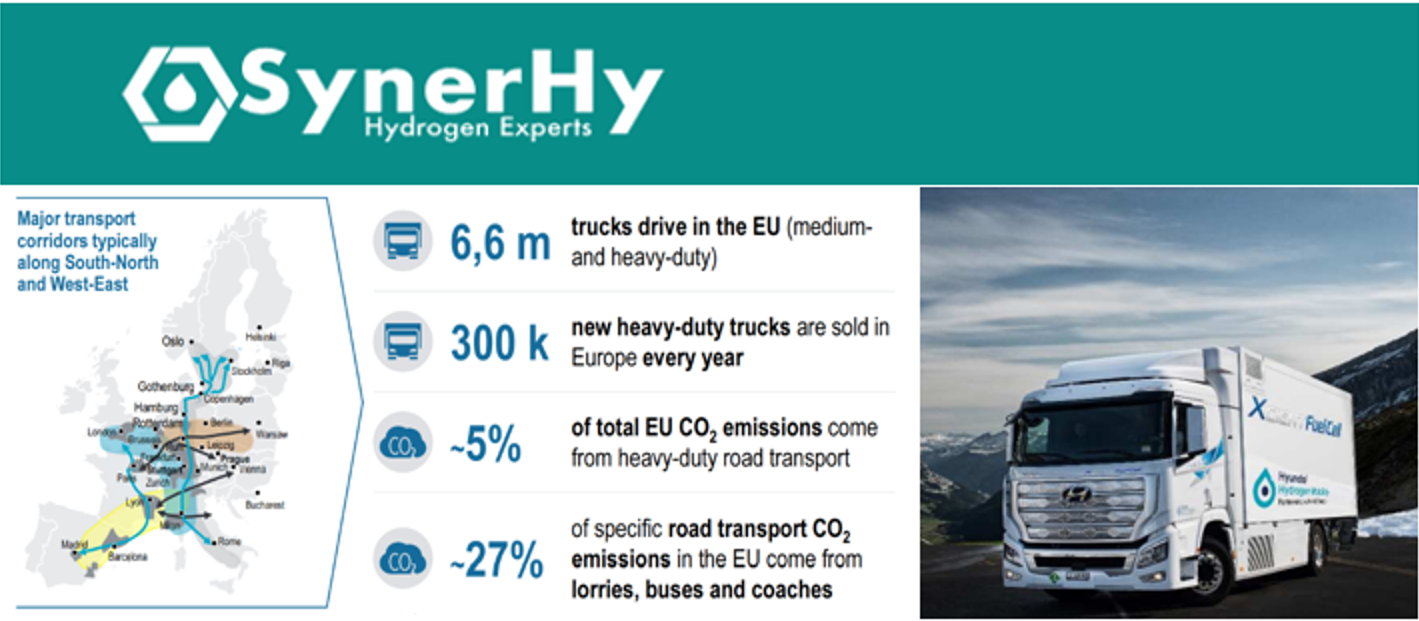
Figure 1. Characteristics of heavy road transport in Europe (source FCH)
The following article will focus on the technologies that are either already on the market or prototypes that are already on the worldwide roads. As mentioned above, the decarbonisation of heavy-duty vehicles (HDV) is a key goal against climate change, especially in Spain, where road transport is a key player as part of the national supply chain. Let us now analyse the wide range of solutions that hydrogen has to offer.
Trucks that can store hydrogen compressed to 350 bar
These are the most developed sector of heavy-duty fuel cell vehicles in terms of technology. There are already trucks equipped with this technology on the global market, and some are already on the roads of Europe, North America and Asia. In order to provide a technical description of these models, we will focus on two leading manufacturers in this field, Hyundai Motor Company and Hyzon Motors.
Hyundai, the Korean automotive group, was the pioneer in the sector of H2-powered fuel cell trucks. Hyundai trucks can be found on Swiss and Central European roads since 2020 as part of a pilot project designed by the Hyundai Motor Company consortium and Zurich-based H2Energy, which aims to launch 1,600 Xcient fuel cell trucks plus H2 charging infrastructure into the Swiss and European market. First 50 trucks were delivered to its customers between 2020 and 2021. These trucks are provided to companies on a pay-as-you-go model, charging a fixed fee per kilometre according to the driving profile, vehicle use and annual mileage. Additionally, the per-kilometre fee also covers hydrogen refuelling and maintenance of the vehicle. The first models arrived at North America in 2022, at California to be precise.
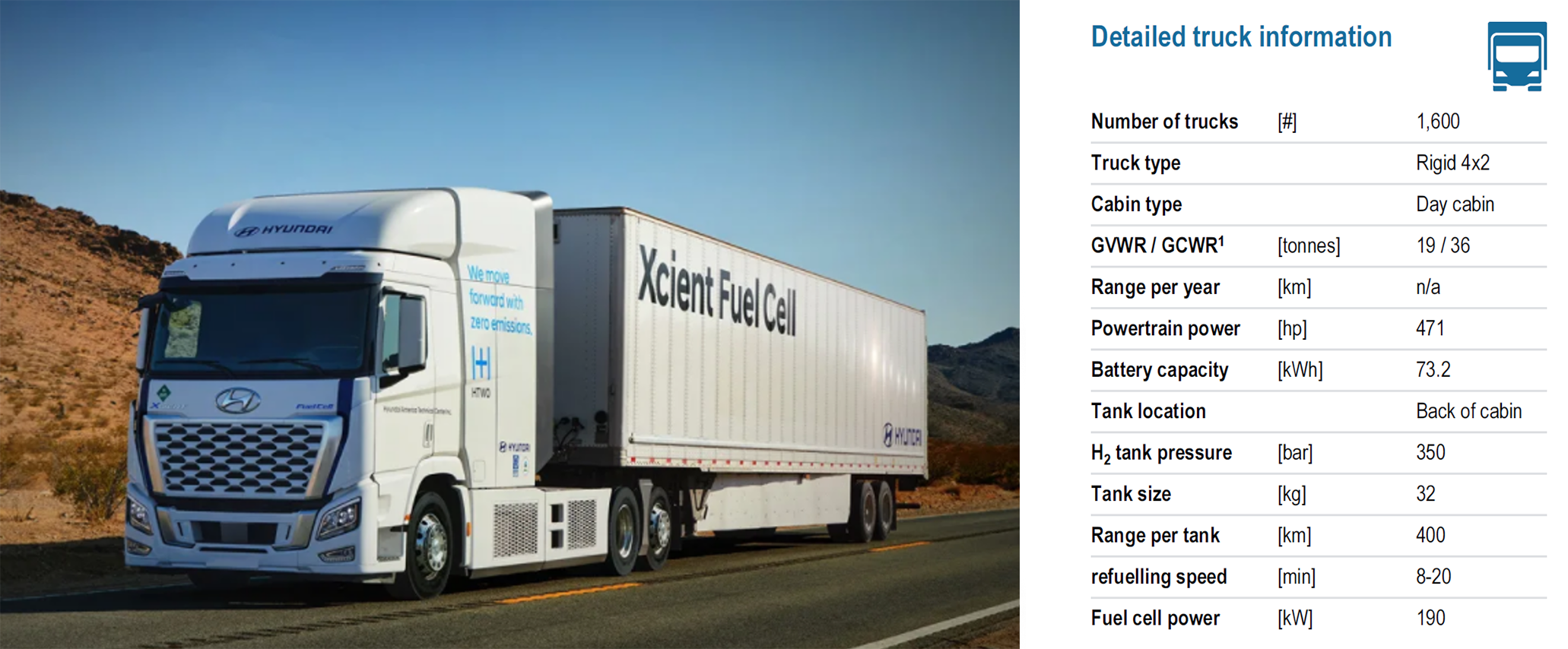
Figure 2. Technical specifications of Hyundai Xcient Fuel Cell (source FCH/ Hyundail)
The Hyundai Xcient is a mid-tonne cargo model, 19 tonnes here, and can be combined up to 36 tonnes. It has four footholds and two 4X2 traction points. Refuelling time can vary between 8-20 minutes and it can achieve an ideal range of 400 km, subject to ground conditions. H2 storage is provided by 7 H2 tanks at 350 bar, which is about 32 kg of H2 at full capacity. The fuel cell is a dual 90 kW (180 kW) stack supported by a 630 V, 72 kWh capacity battery which can store the braking energy. As a result, the stack and battery combined can drive a maximum power output of 350 kW.
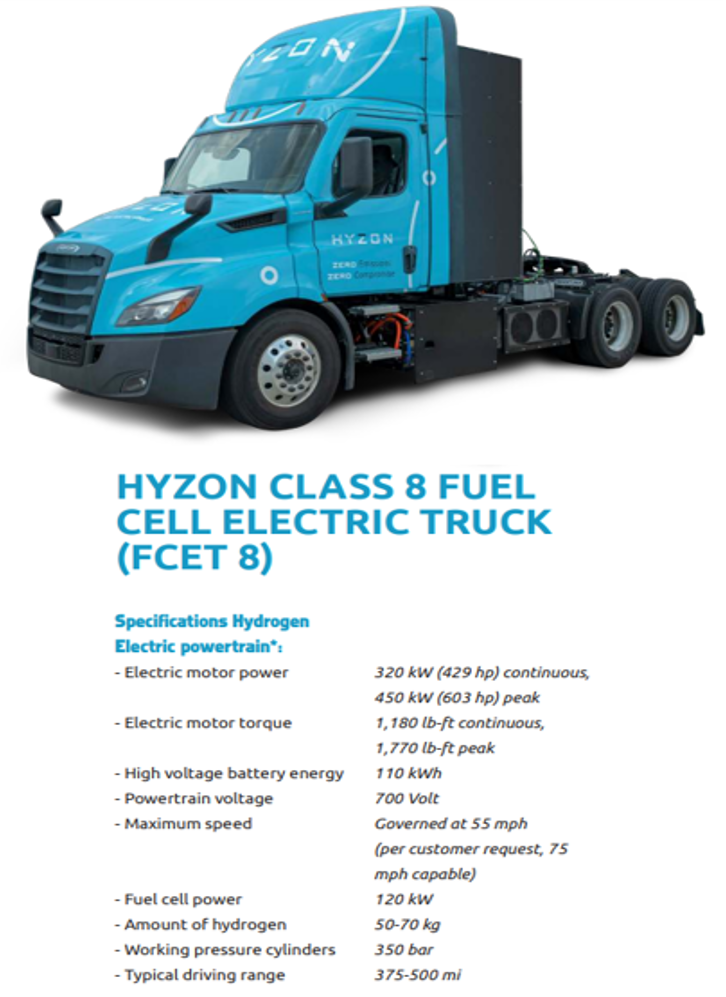
Next, we will look at the specifications of Hyzon Motor trucks competing with the Hyundai Xcient in the same market segment to discuss the differences between both manufacturers. The American company based in Rochester (N.Y.) has a wide range of light and heavy-duty hydrogen trucks. Light-medium duty trucks from 6-20 ton (40-80 kW battery power) and heavy trucks from 40-150 ton (100-150-200-370 kW) with three and four axles.
Hyzon’s Class 8 FC model shows a storage capacity of 50-70 kg of compressed hydrogen at 350 bar. 3-axle truck with 375-500 mile (600-800 km) range and 450 kW peak power, using a 120-kW cell and a 110 kWh backup battery. Hyzon is also developing trucks in the municipal urban rubbish collection field in which they are the leading companies, alongside the German manufacturer Faun. As a technical detail, the image shows the powertrain of a Hyzon truck at Hyzon’s assembly line in Wynschoten (the Netherlands). The difference to the Hyundai Xcient Fuel Cell consists of the 10 tanks in two rows at different heights, versus the Hyundai model’s single-line arrangement of 7 tanks.

Figure 3. Placement of storage tanks on Hyundai’s Xcient (left) and Hyzon’s Class 8 (sources Hyundai and Hyzon-Twitter)
Further hydrogen models or prototypes powered at 350 bar can be mentioned. There are pilot projects at a lower stage of development (or simply high R&D component projects) of fuel cell trucks with storage capacity up to 350 bar. To mention a few, the Ballard/VDL consortium, the Scania/Asco consortium with Cummins fuel cell (Hydrogenics) or the Canadian Freightliner/Daimler consortium with Ballard fuel cell.
Trucks that can store hydrogen compressed to 700 bar
The Arizona-based American manufacturer Nikola Motors is the major developer of storage up to 700 bar on fuel cell trucks. Nicknamed the “Tesla of trucks”, Nikola provides both battery and hydrogen-powered truck technology. The American manufacturer has developed three different models so far: the Nikola One, Two and Tre. The following table shows some of their technical specifications.
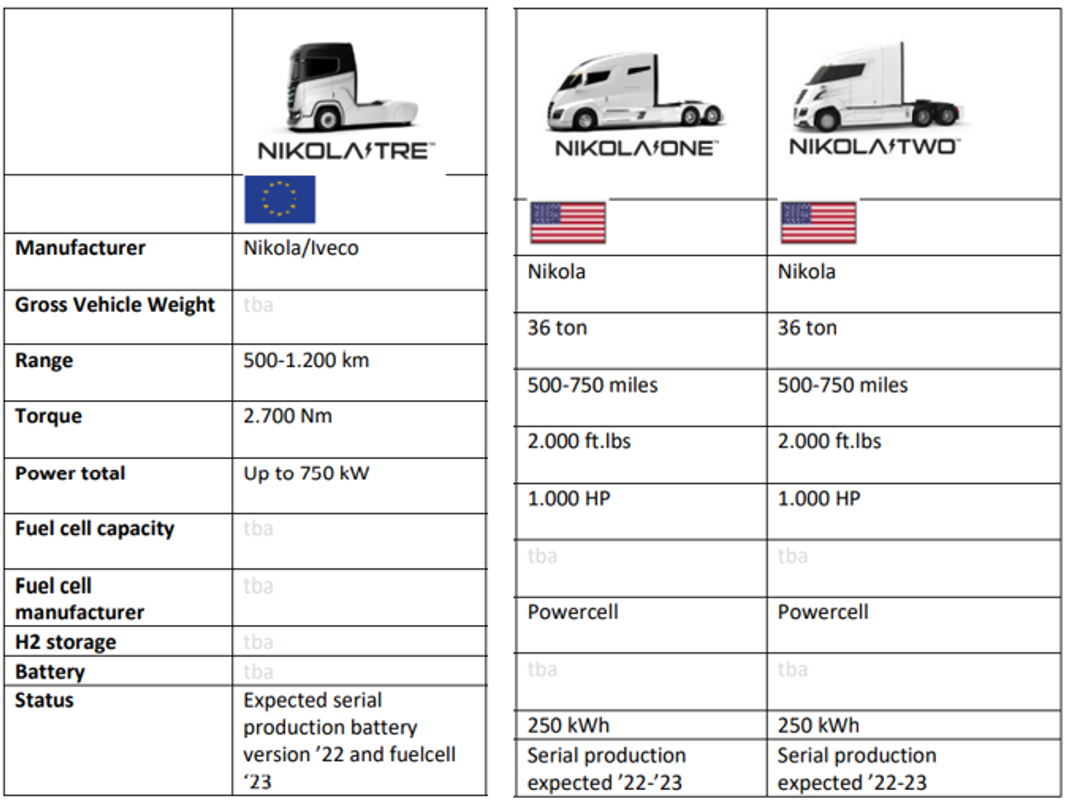
The Arizona manufacturer’s models have very high ranges (from 500 to 1,200 km) since their 6 tanks store up to 81 kg of hydrogen compressed at 700 bar. They are 36-ton vehicles (HDV) with maximum power ratings of over 750 kW (fuel cell and battery). As can be seen in the figure, Nikola and the Italian industrial group Iveco have formed a joint venture to work together on the development of two models (Two and Tre, a nod to their Italian partner) at the EU, more precisely in Ulm (Germany). Due to the greater storage capacity of these trucks, the mileage ranges achieved are significantly greater. The following image shows where the storage tanks are located on the truck. The Nikola Tre model has 6 storage tanks, four at the rear of the cab (see image) and two on each side of the chassis. To increase the mileage ranges achieved by the truck, more tanks are under study for next models.
In September 2021, the company signed an agreement with Bosch to use its fuel cells for the consortium’s trucks. The Nikola Tre Class 8 long-haul Nikola Tre is expected to be powered by the German giant’s fuel cells by 2023 (see photo of the fuel cell).
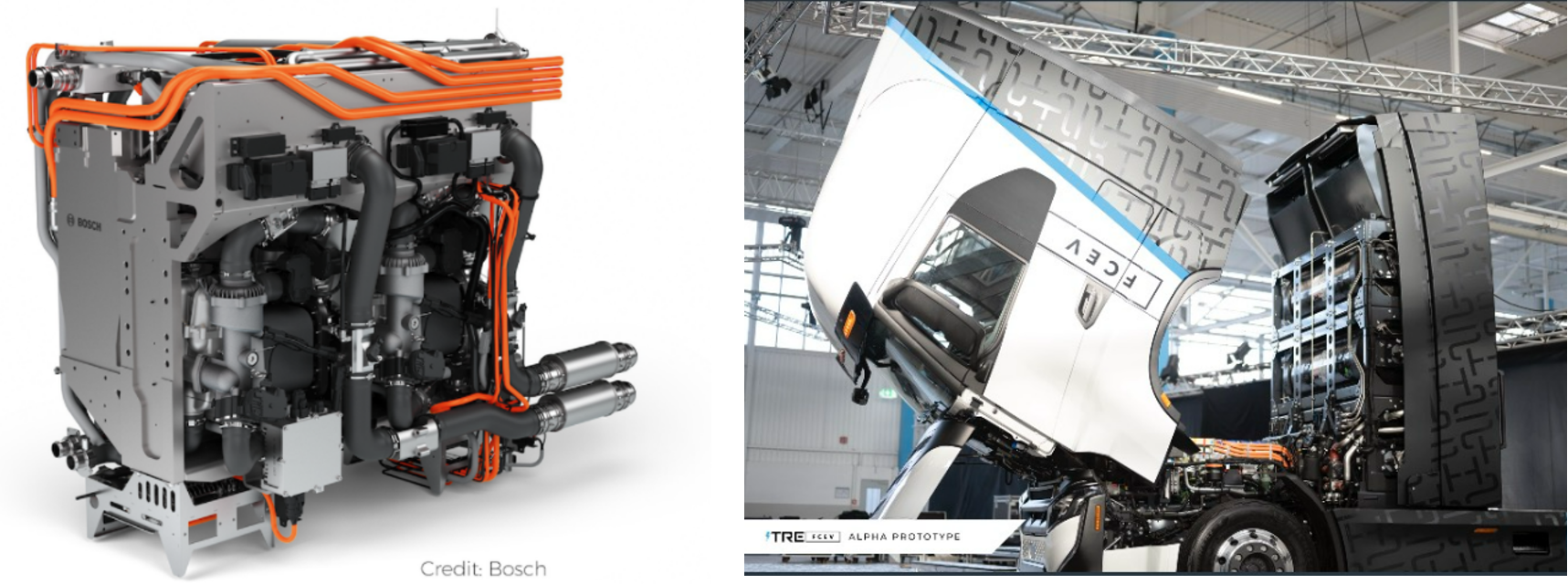
Figure 4. Fuel cell for Bosch and Nikola Tre truck (source Bosch and Nikola websites)
Main differences between 350 and 700 bar FCH trucks
To summarize all the above, the main difference between both trucks is the higher mileage range of 700 bar trucks compared to the 350 bar ones. The refuelling time is usually slightly lower for the 350 bar trucks, although it is very similar.
The investment costs for hydro generators or hydroliners are significantly lower for the 350. For the 700 bar trucks, the refuelling station has to store hydrogen above 900 bar, which exponentially increases the cost of the storage unit. Moreover, if we add the costs of instrumentation and control of the plant (which is more complex), the price of this solution is significantly higher. Therefore, the investment is much higher for the 700-bar technology.
Furthermore, the 700-bar vehicle powertrain is technologically more developed (storage tanks, valves, more developed sensors, etc.), which means a higher investment for this solution.
Liquid hydrogen LH2-powered trucks
To discuss about vehicles capable of storing liquid hydrogen (LH2) inside, we must travel to the beginning of the 21st century and mention the BMW 7, the first vehicle to use this type of storage technology. BMW 7 was commercialized between 2005-2007 as a limited edition, supplying the hydrogen to a special 12-cylinder hydrogen internal combustion engine. Besides the energy needed to liquefy this hydrogen (hydrogen is found in its liquid form from -252.8 °C), the hydrogen-powered combustion engine needed a large amount of hydrogen (gray) to power it, which made this technology hardly efficient and not very “green” or sustainable. There were also many problems to properly isolate the LH2 storage tank inside the vehicle, whereby the entire amount of LH2 could be vaporized within a mere 10 days. However, cryogenic storage technology has evolved greatly over the last decade, using vacuum technologies and materials with high thermal isolation capacity, such as perlite.

Figure 5. BMW 7 hydrogen version (source BMW website)
Thanks to the development of fuel cell and electrolysis technology, efficiency and sustainability are diametrically the opposite to 2005. The German manufacturer Daimler (in technological partnership with Swedish group Volvo) is the leading supporter of LH2 liquid hydrogen technology for long-haul trucks. Mercedes-Benz unveiled the Mercedes-Benz GenH2 Truck at the end of last year, a prototype of a hydrogen truck that is the flagship of its zero-emission road transport initiative, which offers a range of up to 1,000 km. This model’s prototypes are currently being tested on German roads, thus moving a step closer to series production, which is scheduled for 2027.
The total gross weight of the truck is 40 tons. The GenH2 prototype is equipped with two stainless steel liquid hydrogen tanks for a total storage capacity of 80 kgs (40 kg each) located on both sides of the truck (see image). Besides, the pre-series version has two electric engines each providing 230 kW of continuous power (with peaks of up to 330 kW) and a maximum torque of 2,071 Nm. Mercedes aims to reach 1,200 km of range with further developments of its GenH2 model.
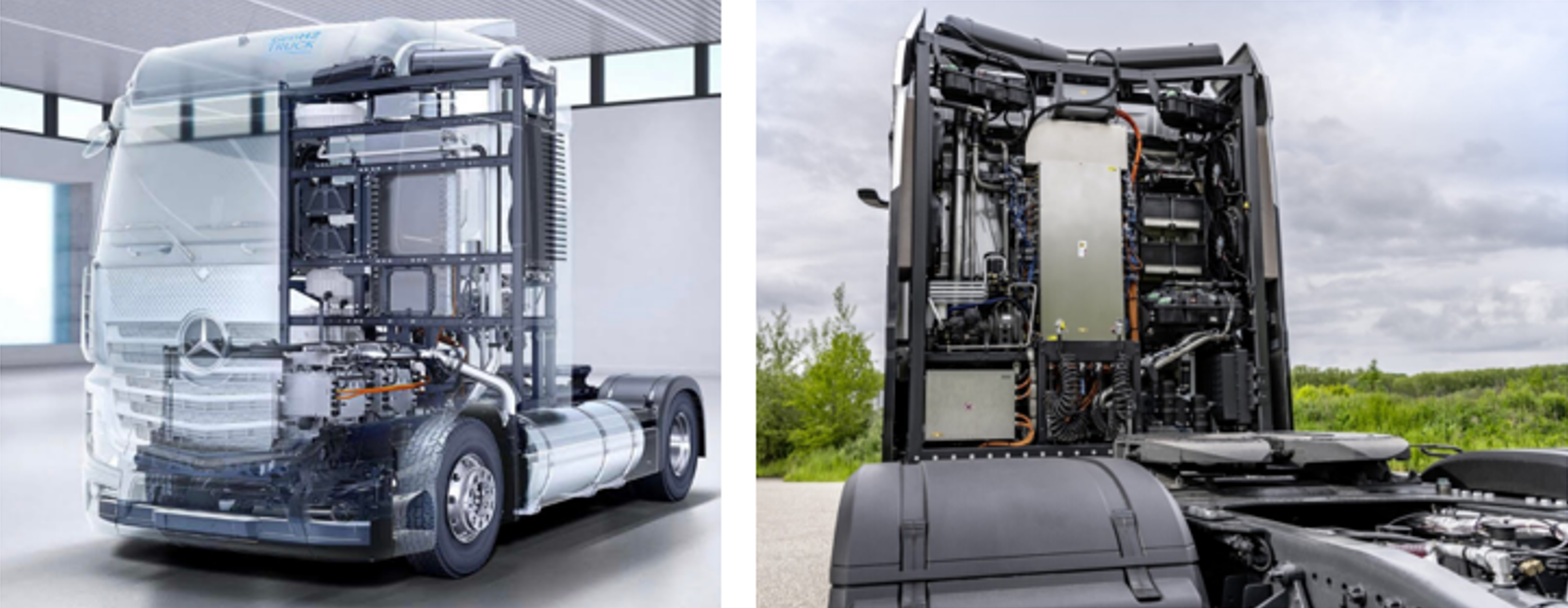
Figure 6. Mercedes Benz GenH2 (Daimler Truck web images)
The manufacturer Daimler Trucks prefers using liquid hydrogen in its long-haul models because this energy carrier has a much higher energy density in terms of volume than compressed gaseous hydrogen. As a result, tanks for a fuel cell truck using LH2 are much smaller and even lightweight due to the reduced pressure they have to withstand. This means more cargo space as well as a higher payload. In addition, more hydrogen can be transported and stored inside both tanks, which considerably increases the range of the trucks. Safety advantages in comparison to compressed gaseous hydrogen are obvious, as it is almost decompressed in its liquid form.
The following video shows the ongoing tests being carried out on road with the prototypes. These tests are focused on checking the performance of all components in different weather and road conditions, as well as in different driving manoeuvres. These tests are very severe and must fulfil the same endurance standards as other Daimler models such as the conventional Mercedes-Benz Actros diesel, which covers 1.2 million kilometres on road over a decade and reaches a total of 25,000 operating hours, as reported by Mercedes itself.
The German MAN Group, jointly with the start-up Cryomotive and the Technical University of Munich (TUM), intends to develop a new prototype truck based on cryogas technology.
Conclusions
As Synerhy stated several times, some sectors are difficult to electrify, and renewable hydrogen offers an essential solution for their decarbonization in addition to being 100% sustainable. Long-haul transport is one of them. The expected ranges for fuel cell trucks are twice as long as for other technologies, refuelling time is far shorter, and there is not such a big burden in terms of mass and volume.
The solution of trucks with compressed hydrogen storage at 350 bar seems to be the best option for medium-tonnage transport and regional day-to-day deliveries of around 300-350 km daily mileage. Indeed, the refuelling infrastructure and the price is more affordable than the other solutions described above.
At the same time, there are two solutions that hydrogen can offer for trucks carrying much heavier loads and very high mileage ranges, either compressed storage at 700 bar or hydrogen in its liquid form (-252.8 °C). The first solution will be on the road commercially by the end of this year and early 2023. The perspectives are excellent, but the scaling up of infrastructure and vehicles is essential to make it financially possible within a few years. At the end of the decade, the liquid hydrogen solution applied to trucks (the writer’s favourite) could be the major disruption within the decarbonized heavy transport sector due to the countless advantages of this technology.
Finally, the Chinese market growth over the last 3 years on the development of buses (coach) and trucks (CNHCT) boosted by its government may represent the rise of a new player in the field of hydrogen and electromobility.
SynerHy offers a multidisciplinary team of professionals ready to realize all projects related to the hydrogen value chain in which you might be interested. Contact us at info@synerhy.com
REFERENCES